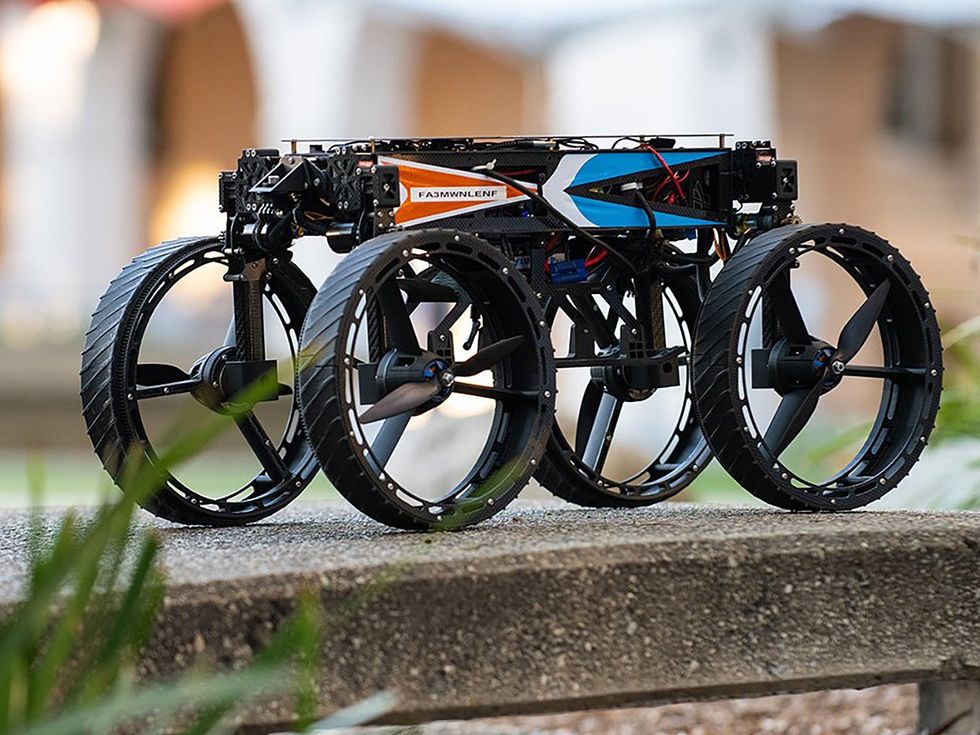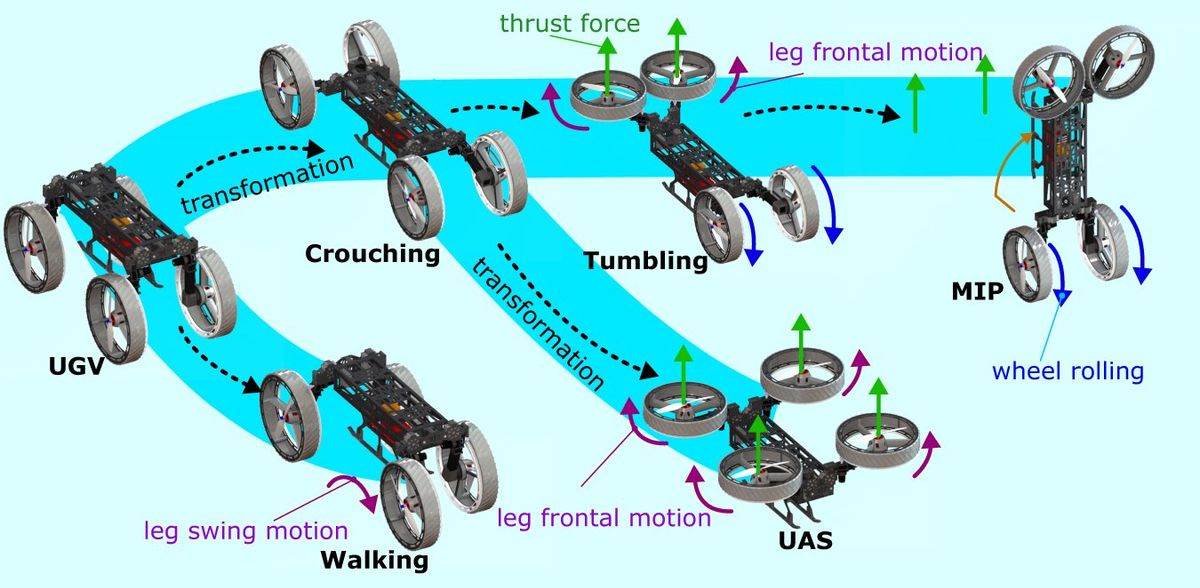Robotics engineers often look to how animals get around for inspiration for more effective and efficient artificial limbs, joints, and muscles. One particularly fruitful source of inspiration comes from studying creatures that use their limbs for different kinds of mobility—think amphibians that both walk and swim, or birds that both walk and fly. Such inspiration has led to the SPIDAR that crawls and flies, the LEO that skateboards and slacklines, and robots that can switch between bipedal and quadrupedal modes.
Now engineers at Caltech and Northeastern University (in Boston) have developed a multimodal robot that can navigate in not two or three but eight different ways—including walking, crawling, rolling, tumbling, and even flying. That said, the Multi-Modal Mobility Morphobot (M4) looks more like a sleek little cart than anything out of a bestiary. M4 is 70 centimeters long and 35 cm high, with four legs with two joints each. It also has two ducted fans at the ends of each leg, which can function as legs, propellor thrusters, or wheels. The robot is surprisingly light—around 6 kilograms—considering that this includes its onboard computers, sensors, communication devices, joint actuators, propulsion motors, power electronics, and battery. It is capable of autonomous, self-contained operations.
The details of M4 were published in Nature Communications on 27 June.
The bio-inspired ‘transformer’ that crawls, rolls and fliesNature Video
Integrating so many modes of transport on a single platform is a first, says Alireza Ramezani, a robotics engineer from Northeastern University and one of the lead investigators. The task called for challenging design considerations: “In multimodal robot design, as the number of modes [of locomotion] increases, each mode introduces its own design requirements,” he says. To integrate all these design requirements, the researchers had to play with various trade-offs.
“When you design aerial robots, you want your systems to be extremely light,” says Ramezani. “But if you want to achieve legged locomotion, you need bulky actuators that can produce torque in the joints for dynamic interactions with the ground surface. These bulky components can negatively affect aerial mobility. And this is just for a system with two modes of mobility.” M4 can walk on rough terrain, climb steep slopes, tumble over bulky objects, crawl under low-ceiling obstacles, and fly.
The researchers took their design inspiration from the locomotion plasticity seen in nature. Morteza Gharib, an aeronautics professor from Caltech and a colead for the project, says that nature was “an open book of design for us,” especially in the way that it repurposes systems in order to deliver functionality. “The unique aspect of [this] robot is that it has the highest number of functionalities with the minimum number of components, and also is capable of making decisions on which one to use for different challenges.”
Repurposing was the key to making the design of M4 scalable—that is, increasing its payload capacity without compromising its mobility. Focusing on how the robot could reuse its existing appendages for different locomotions without introducing added mass freed up payload capacity for computers, sensors, and so on. The scalability was achieved by redundancy manipulation.

In other words, M4 can use its four appendages to roll like a ground vehicle or crawl as a quadruped, but it can also stand up on two appendages. While standing, the robot has a higher vantage point and more dynamic locomotion, but as a quadruped, it has four contact points with the environment and is therefore more stable. “This is [a matter of] finding a balance between the trade-offs introduced by each mode of mobility, and the mechanism to go from one mode to another is through manipulating these redundancies,” says Gharib.
The research team carried out experiments to put M4 through its paces—wheeled and quadrupedal locomotion, unmanned ground as well as aerial locomotion, and more. They report that M4 showed full autonomy in multimodal path planning between traveling on the ground and flying.
Using its onboard sensors and computers, M4 was able to negotiate an unstructured environment by switching from rolling to flying, but the researchers want more. “The next step for us is to have all of [M4’s] modes of mobility being used by the robot in a completely autonomous fashion based on the sensory information that it gathers from the environment,” Ramezani says.
Funding for the M4 project came from the Jet Propulsion Lab at NASA and the National Science Foundation. The researchers expect multimodal robots to play a big role in future space explorations. Recently, NASA integrated an aerial vehicle, the tiny helicopter Ingenuity, into the Mars rover Perseverance to act as a scout for the larger vehicle, and it was a great success, Ramezani points out.
Space exploration aside, the researchers also see potential for search-and-rescue operations, package handling and delivery, environmental applications, and digital agriculture, among others. The system’s ability to change its shape and form gives it many advantages over robots with fixed geometry, Gharib says.
The researchers are still looking to improve M4. “There is no end to what you would like to see from a robot like this,” Ramezani says. “For instance…it doesn’t take much to extend the existing capabilities of M4 to underwater locomotion using its quad copters.” Meanwhile, they also continue to work on making M4’s existing mobility modes more efficient.
Payal Dhar (she/they) is a freelance journalist on science, technology, and society. They write about AI, cybersecurity, surveillance, space, online communities, games, and any shiny new technology that catches their eye. You can find and DM Payal on Twitter (@payaldhar).



